
William Kennedy, 1768 - 1834
William Kennedy was part of the evolutionary chain that brought uilleann pipes to the instrument we now play. He was very much part of the creative and cultural upheaval that changed the face of Europe in the closing decade of the 18th century. This was a time of invention, creativity and above all it was a great period for musical instrument making right across Europe.
Our main source of information about William Kennedy comes from an article written by Francis Joseph Biggar for the Ulster Journal of Archaeology of 1906. This article is based on an interview with the man himself and was in fact taken from a book published in 1821 (when Kennedy was still alive) entitled 'A Biography of the Blind', by James Wilson.
William Kennedy was born near Banbridge in 1768, and lost his sight at the age of four. As was the custom of the time, blind children were sent to learn music, so when William was thirteen, he went to a Mr. Moorehead in Armagh to learn to play the fiddle. He made good progress and remained there for a year and a quarter. While he was in Armagh, he lodged with a cabinet maker and availed of the opportunity to learn to use tools. On returning home, he began to make furniture. He bought an old set of Irish bagpipes and had great difficulty putting them in playing order. Soon he was repairing instruments for the neighbourhood. As he worked he began to think that there might be a better plan for making pipes, so he set to making tools and had his first set completed in nine months.
A local clockmaker was interested in learning to play pipes so they mutually instructed each other. In 1793, Kennedy married and in order to support his wife and family, he worked for the next twelve years making and repairing instruments of all kinds. He also made clocks, ordinary clocks and musical clocks; he made linen looms and occasionally made furniture. His principal employment, however, was making Irish bagpipes, as he says himself "of which I have made thirty sets these past eight years".
The writer then continues with a description of Kennedy's innovations in pipemaking. He added keys to the chanter, so that flats and sharps could be played; he extended the range of the chanter so that it could play high E; he added additional notes to the organ-stop (presumably the regulator) so that some of its notes are capable of being varied from naturals to sharps according to the key in which the tune is played; he added two large keys managed with the wrist, so that part of the basses, or all of them, can be stopped or opened at pleasure. All in all, an amazing accomplishment for one who was blind.
The next few lines of Biggar's article are worth quoting in full:
"From a rude block of ebony, a fragment of an elephant's tooth and a piece of silver, having first formed his lathe and his tools, he shapes and bores the complicated tubes, graduates the ventage, adapts the keys, and forms the instrument of perfect external finish and beauty that discourses most eloquent music, capable of expressing the finest movements in melody, and by no means deficient in harmony; and all this by the exquisite sensibility of touch, for he is stone blind and quite incapable of distinguishing the black colours of ebony from the white of ivory."
Occasional references to Kennedy appear from time to time, usually on the topic of his blindness. One such appeared in the Newry Magazine in 1815.
"Kennedy can distinguish by the touch, on any kind of watch in common use, the time of day to a single minute, by merely gliding his fingers around the dial plate, and thus ascertaining the position of the hands. He is an excellent judge of fine and superfine cloth and has often been brought to Newry, and his expenses paid, for selecting choice pieces of that article for wear."
T.G.F. Patterson, who was the curator of Armagh Museum, added a few more details to the picture. Kennedy made an excellent writing cabinet for Mrs. Reilly of Scarva, where he met the celebrated piper Downey, and it was here that Kennedy first became interested in pipes. An interesting link with this story is that Mrs. Reilly was taught to play the harp by a blind harp player through the medium of Irish which would have been spoken extensively in this area at the time. According to Patterson, Kennedy lived in Mullabrack, near Markethill in 1798 and moved to Tandragee to work in 1800.
There is no reference to Kennedy in O'Neill's Irish Minstrels and Musicians, although he does mention a John Moorehead, whose father, a piper and fiddler taught Kennedy as a child in Armagh. John is credited with composing the tune 'Speed the Plough', sadly he ended his life by committing suicide.
Kennedy next appears in an article in the Armagh Guardian in 1868 in a moralising anecdote on the importance of hard work. A neighbouring lad, George Fritzell, who loved to idle away his days, was driving his father to despair. One day when a crowd including the idle George was gathered in Kennedy's shop, William was asked to explain how he was able to do such amazing work without sight. Kennedy told his audience how he had to learn to accustom himself to judge by hearing and feeling. He hated to hear his parents being pitied for the burden that God had imposed on them. He resolved to use his other faculties to make himself as useful as possible. He learned to know that the will, aided by a sense of duty, accomplishes anything. He realised that he would need several occupations to render him independent. The happiest day of his life was when he was able to support his aged parents. Now they are dead and he says
"The only thing I ask of God now is health, for as to fortune, He has given me an exhaustless one in my workshop. The blind ones in this world are not they who cannot see the sun, but they who cannot see duty".
The next day, young Fritzell returned to the shop begging to be taken on as an apprentice.
Another article, this time taken directly from 'A Biography of the Blind', appeared in the Banbridge Chronicle in February 1880.
It was more difficult to find information on Kennedy's death until a friend of Jim Blaney's who was interested in the history of clocks, discovered that he had died in 1834. We located his obituary in the Newry Telegraph of November 11th 1834; he had died on October 29th 1834 - and we had unknowingly organised our first William Kennedy Festival almost on the 160th anniversary of his death.
"The late William Kennedy, of Tandragee.
Died, at Tandragee, on the morning of the 29th ult., Mr. William Kennedy, one of the most extraordinary men who have appeared in these latter times. Though totally deprived of sight, he was enabled, through his industry, his perseverance, and his genius, to execute with precision, taste and judgement, various elaborate works of a nature which have heretofore required the utmost exertions of well trained artists, in full possession of all the senses and faculties with which nature had endowed them. This ingenious man fabricated his own tools, and with ease he constructed time-tellers, bagpipes, flutes, and various other instruments of music. He invented also a particular kind of bagpipe, by means of which he was enabled to regulate the bass at pleasure, so as to render it at all times accordant with the varied modulations of the airs which he chose to perform. It possessed great sweetness, depth, and organic power. By frequent use, the points of his fingers, which seemed in some respects to resemble horn, were capable of discriminating the most minute objects by the touch. Strange as it may appear, he was fully adequate to the tuning and repairing of organs, however numerous their stops and complicated their machinery. Add to this, that he was a kind-hearted, friendly, industrious, moral and religious man; an affectionate husband, a fond parent, and, in all respects, an useful and justly esteemed member of society. - Guardian."
Unfortunately only a few Kennedy sets have come to light, making it very difficult to evaluate his contribution to pipe-making as described by Francis Joseph Biggar. Pipe maker Ken McLeod has written on this subject in the journal "An Píobaire" where he has posed some questions and made some suggestions regarding the interpretation of Biggar's article.
There has long been discussion on the various names given to the pipes e.g. Irish pipes, Union pipes and Uilleann pipes or simply just bagpipes. Biggar & Kennedy refer to them as Irish pipes; O'Farrell's Treatise published in 1801 calls the instrument Union pipes. Why Union? One theory is that "Union" came from the union of two instruments - pipes & organ; another, the union of drones and regulators; another connects the name to the Act of Union; yet another to the United Irishmen; the theory which Ken considers most likely is that of the union of the melodic and the harmonic. Most people agree that the term 'uilleann' only dates back to the Gaelic revivalists.
Was Kennedy the first to put keys on a chanter? O'Farrell's Treatise does not mention keys. Kenna, Coyne, & Egan pipes generally have at least four keys. Did Kennedy invent a high E key? Ken also discusses the organ stop referred to by Biggar. Was this a regulator? Perhaps Biggar had not heard of this term. It is possible that O'Farrell invented both of the terms "regulator" and "Union Pipes". The small number of sets which have come to light have one regulator and three drones. Only the set owned by Trevor Stewart appears to be stamped with the maker's name.
References to "tuneable" drones and regulator are a bit mystifying unless they simply refer to tuning pins. Quoting Biggar again "by the addition of two large keys, managed with the wrist, a part of the basses or all of them, can be stopped or opened at pleasure." This may be a reference to a stop key, and Ken suggests that Kennedy may have invented this. However, the Armagh set does not have this facility - perhaps it is a very early set. Biggar mentions that Kennedy's pipes were made from ebony; the sets that we know of are either of boxwood or in the case of the Armagh set, of pear wood, appropriate enough in the Orchard of Ireland.
The world of pre-Famine piping in Ireland has still not yielded up all its secrets. It still poses a challenge to the music historian. With all the unanswered questions about Kennedy we still know more about the man than any of his contemporaries. What comes across clearly in all he writings which now span almost 200 years is the esteem in which he was held and the impression he made on all who met him.
The William Kennedy Piping Festival
The William Kennedy Piping Festival celebrates the life and work of William Kennedy, the 18th century piper, pipe maker and inventor who was born in 1768 near Banbridge and died in 1834 in Tandragee, County Armagh.
This Festival, originally conceived to bring together pipers from different countries and traditions, was the first of its kind anywhere in Northern Europe. To date the event has brought pipers from Spain, France, Italy, Bulgaria, Hungary, Belarus, Canada, USA, England, Scotland, and Wales as well as the cream of Irish pipers to Armagh.
The festival is organised by Armagh pipers Club which was founded in 1966 and has been to the forefront of traditional music not just on a local scale but worldwide through our publications and teaching programme over all those years.
The William Kennedy Piping Festival has been a voyage of discovery that began with the inaugural festival in 1994. This voyage began in a most unexpected way when Hamish Moore produced 3 pipes of varying lengths out of his pipe case during an illustrated talk in the auditorium at St Patrick's Trian.
As he began to explain these strange pipes I suddenly made an intuitive connection and looked at the Armagh Pipers Club badge which I had designed almost 25 years previously. Hamish was telling us that these pipes were inspired by a carved panel on the 8th Century High Cross (Cross of St Martin) on the Isle of Iona situated just off the Isle of Mull on the West coast of Scotland. He further explained that a similar Triple Pipe instrument called the Launeddas was played to this day in Sardinia.
The Armagh Pipers Club badge was based on a carved panel on the 9th Century High Cross at Clonmacnoise which Brendan Breathnach had drawn my attention to sometime in the late 1960's at one of the early Na Piobairi Uilleann gatherings. It immediately became clear to me at this stage that our Festival (founded on the well documented shared cultural inheritance of Ireland and Scotland reflected in gaelic song, scots ballads, instrumental music particularly piping and fiddling and the various dance traditions of both countries) was never going to be the same again.
The immediate link between the High Crosses was easy enough to explain - the link was St Colmcille known in Scotland by his latin name St Columba. What was not so easy or comfortable but exciting was the Sardinian link. What was this all about?
After a lot of research we finally tracked down a Sardinian Launeddas player by the name of Luigi Lai. We invited him to Armagh not really knowing what his music was about. However Luigi's arrival was a milestone occasion in the history of the William Kennedy Piping Festival. This unassuming man produced a series of canes from his box and proceeded to play for 14 minutes non stop. When he finished there was a standing ovation that equalled the length of the piece he played. Luigi has returned on two further occasions and both times stole the show again.
Brian Vallely
|
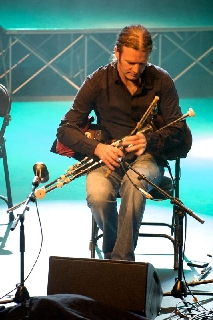 Cillian Vallely @ FolkWorld: |
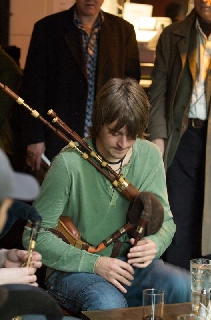 Ross Ainslie @ FolkWorld: |
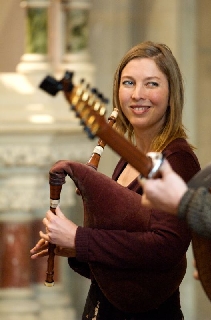 |
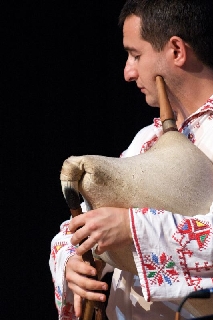 Ivan Georgiev (Bulgaria) |
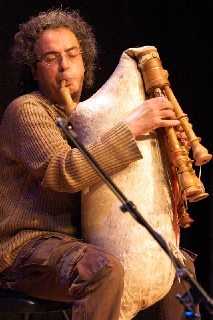 Giancarlo Parisi (Sicily) |
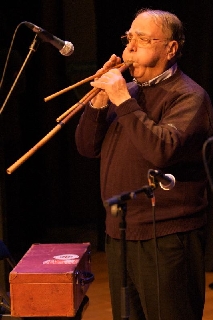 Luigi Lai (Sardinia) |
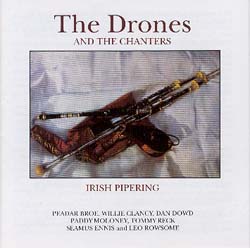 Kennedy Pipes
Kennedy Pipes
 Triple Pipes
Triple Pipes
